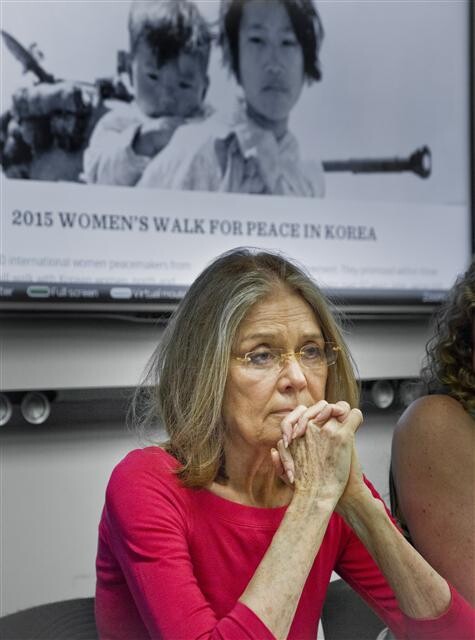hankyoreh
Links to other country sites 다른 나라 사이트 링크
Women get South’s permission to cross DMZ from North Korea

The South Korean government granted permission for female peace activists from around the world to cross the peninsula’s Demilitarized Zone (DMZ) on foot.
While it recommended that participants use the Gyeongui railway to cross from North to South, the organizers reaffirmed their plans to cross at Panmunjeom as originally planned.
The Ministry of Unification announced on May 15 that it was “granting permission for participants in the WomenCrossDMZ Peace Walk to cross the DMZ.”
It also announced plans to “recommend that the group use the Gyeongui Line route” to cross into the South, citing quarantine and other entry procedures and precedent.
“Panmunjeom is the region where the armistice system is managed, which makes it an unsuitable place for entry and exit,” said a ministry official.
“It would be appropriate to use the Gyeongui Line land route, for which transit procedures between North and South have been agreed upon [through the Gyeongui Line Inter-Korean Transit Office],” the official explained.
Participants in the Peace Walk, which is being led by world-renowned women’s rights activist Gloria Steinem, are adamant on their original plan of crossing at Panmunjeom.
“As long as they’re not going to arrest us for illegal entry, our plan is to come down via Panmunjeom,” said Peace Walk committee co-chair Vana Kim in a May 15 telephone interview with the Hankyoreh.
The organizers’ position is that the Peace Walk’s passage at Panmunjeom would be significant in terms of the goal of bringing about reunification and peace on the Korean Peninsula, since the location is recognized as a symbol of the peninsula’s division since the 1953 armistice agreement that halted the Korean War.
The administration has no plans to arrest participants for illegal entry if they go ahead with the crossing at Panmunjeom, sources reported.
“If they do cross at Panmunjeom, the exit and entry procedures will be carried out through the Gyeongui Line Inter-Korean Transit Office,” a government official said.
To date, the only official instance of a person crossing the DMZ on foot after discussions and approval by North and South Korean authorities and the UN Command, which oversees the DMZ, came with former President Roh Moo-hyun’s visit to North Korea for an inter-Korean summit in Oct. 2007. Lim Su-kyung, now a lawmaker for the New Politics Alliance for Democracy, walked back to the South through Panmunjeom’s Joint Security Area on Aug. 15, 1989, after secretly entering North Korea the previous July as a special envoy from the National Council of University Student Representatives, but was later punished for violating the National Security Law. Lim had previously staged a six-day hunger strike in North Korea after authorities there refused to permit the Panmunjeom crossing.
The administration’s approval for the Peace Walk plan appears to be an extension of a more general trend toward allowing more civilian exchanges to improve inter-Korean relations.
“Our policy is to allow as wide a range of civilian exchanges as possible,” a Ministry of Unification official affirmed. The aim appears to be to create opportunities for more varied exchanges going ahead.
The Peace Walk organizers previously requested government approval for around 40 participants to cross from North to South at Panmunjeom on May 24. North Korea announced its plans to support the event on May 2. Participants will travel via Beijing to Pyongyang, where a joint event is scheduled on May 19 with the North’s “preparatory committee for the international women’s march for peace and the unification of Korea.”
After arriving in South Korea on May 24, they are scheduled to take part in a “Peace Festival with WomenCrossDMZ” event at Imjingak Pyeonghwa-Nuri Park in Paju, Gyeonggi Province, before returning home on May 26.
By Kim Oi-hyun, staff reporter
Please direct questions or comments to [english@hani.co.kr]

Editorial・opinion
![[Column] Season 2 of special prosecutor probe may be coming to Korea soon [Column] Season 2 of special prosecutor probe may be coming to Korea soon](https://flexible.img.hani.co.kr/flexible/normal/500/300/imgdb/original/2024/0426/3317141030699447.jpg) [Column] Season 2 of special prosecutor probe may be coming to Korea soon
[Column] Season 2 of special prosecutor probe may be coming to Korea soon![[Column] Park Geun-hye déjà vu in Yoon Suk-yeol [Column] Park Geun-hye déjà vu in Yoon Suk-yeol](https://flexible.img.hani.co.kr/flexible/normal/500/300/imgdb/original/2024/0424/651713945113788.jpg) [Column] Park Geun-hye déjà vu in Yoon Suk-yeol
[Column] Park Geun-hye déjà vu in Yoon Suk-yeol- [Editorial] New weight of N. Korea’s nuclear threats makes dialogue all the more urgent
- [Guest essay] The real reason Korea’s new right wants to dub Rhee a founding father
- [Column] ‘Choson’: Is it time we start referring to N. Korea in its own terms?
- [Editorial] Japan’s rewriting of history with Korea has gone too far
- [Column] The president’s questionable capacity for dialogue
- [Column] Are chaebol firms just pizza pies for families to divvy up as they please?
- [Column] Has Korea, too, crossed the Rubicon on China?
- [Correspondent’s column] In Japan’s alliance with US, echoes of its past alliances with UK
Most viewed articles
- 1No good, very bad game for Korea puts it out of Olympics for first time since 1988
- 2Division commander ordered troops to enter raging flood waters before Marine died, survivor says
- 3Korea’s 1.3% growth in Q1 signals ‘textbook’ return to growth, says government
- 4Will NewJeans end up collateral damage in internal feud at K-pop juggernaut Hybe?
- 5[Column] Season 2 of special prosecutor probe may be coming to Korea soon
- 6[Editorial] Korea’s surprise Q1 growth requires objective assessment, not blind fanfare
- 7[Column] ‘Choson’: Is it time we start referring to N. Korea in its own terms?
- 8‘We must say no’: Seoul defense chief on Korean, USFK involvement in hypothetical Taiwan crisis
- 9Korea sees more deaths than births for 52nd consecutive month in February
- 10Is N. Korea threatening to test nukes in response to possible new US-led sanctions body?